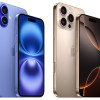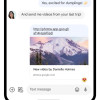Review: iPhone
The first time I saw the screen I swore it was fake. I asked the Apple Store employee to show me a working one and not a dummy. Although it is very high resolution (160 pixels per inch), the iPhone does not exhibit any of the graininess common to small, high-resolution screens we've seen on previous generations of Japanese mobile phones.
With the brightness set to its default of 50% and the light sensor activated, the screen is plenty bright for use - even in the California summer sun.
The touch part of the screen is surprisingly sensitive. The less there is to touch on a screen, the more sensitive and responsive it becomes. For example, the camera only has two small on-screen buttons and the rest of the screen is a viewfinder. In this case just the slightest touch triggers a button press. In cases where there is more on the screen, a normal amount of pressure - about the same or just less than you might use to press a key on another phone - is enough. The press is very intuitive, and animations and sound provide feedback in place of a physical click, the same way the click of an iPod scroll wheel tricks you into believing you're moving something.
We were immediately able to accomplish most tasks from dialing to "pinch" zooming with no problems. But the question in most peoples' minds is: what about entering text? There is definitely a learning curve to entering text. Despite the suggestion of Apple and early reviews, I had been using two thumb texting for too long to start with one index finger. The first 10 times I tried to tap out anything, it was frustrating at best. I cursed and screamed in pain. Entering text that can't take advantage of error correction like URLs or city names in the weather widget was especially difficult at this stage.
(There are more photos of the keyboard in action when we get to text messaging.)
In Safari, you can switch to landscape view, and then enter text using a much larger keyboard, but - surprisingly - we didn't find it any easier to use, especially at this early stage familiarity.
However things improved quickly. After about 10 text messages, we started to trust the automatic error correction. And even though we were flailing all over the small keyboard, our text messages looked surprisingly accurate. Only rarely did we have to tap and hold on the text to bring up the magnifying glass that lets you move the cursor to make edits. After using the iPhone for the first night, using the keyboard was no longer a challenge. Sure it was a bit slower than the phones we were accustomed to using, but it was still faster than most T9 users. And our speed and accuracy continues to improve. One thing Eric L noticed is that you will wind up using the side or tip of your thumb instead of the flat pad of it once you realize how much this improves your accuracy.
After using the iPhone for less than 48 hours, none of us feel slow on it, and all of us are sending long texts and short emails on it with no problems. URLs, proper names, and passwords are still a pain to enter, though.
Many commentators have noted that the glossy glass screen attracts finger oil smudges. While technically true, we found it to be a complete non-issue for us. You only notice the smudges when under bright light and the screen is completely off. If you're holding the iPhone and looking at it, you almost certainly have the screen on, because otherwise you're just staring a big black slab of nothing. When the screen is on, it's bright enough that you never notice smudges, even after a full day of use. You might want to wipe it off once a day, but that's about all we found we needed. Unless you plan on displaying it on a pedestal under direct sunlight, you probably won't notice any smudges unless you inspect for them.
It took quite a bit of fiddling with our studio lights to get just the right angle to take a photo that shows any smudges at all; normally they are very difficult to see. Once the screen is on, the smudges all but disappear. You can still make them out, but only because we still have the carefully-placed studio light at just the "wrong" angle, which isn't normal lighting for most situations. In fact, we didn't even need to wipe the screen before taking any of the other screen shots in this whole article.













 CES 2007 + iPhone
CES 2007 + iPhone
 iPhone 14 Plus Offers a Big Screen For Less
iPhone 14 Plus Offers a Big Screen For Less
 iPhone 15 Series Goes All-In on USB-C and Dynamic Island
iPhone 15 Series Goes All-In on USB-C and Dynamic Island
 iPhone 16 Brings More Features to All Price Points, Including New Camera Control
iPhone 16 Brings More Features to All Price Points, Including New Camera Control
 Major Update to Google Messages Brings iPhone-Compatible Emoji Reactions
Major Update to Google Messages Brings iPhone-Compatible Emoji Reactions
 Apple iPhone
Apple iPhone


